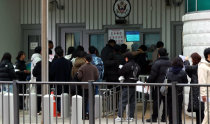[Opinion] Gwanghwamun Restoration Project
[Opinion] Gwanghwamun Restoration Project
Posted January. 26, 2006 03:03,
The reason the Chosun Dynasty built two palaces in Seoul was to prepare for the worst. If there was only one palace, the king would have nowhere to go in the event of a fire or a war. The primary palace was called Bupgung and the secondary palace Yigung. In the early Chosun era, Bupgung was the Gyeongbok Palace, and the secondary Yigung was the Changdeok Palace. When both palaces were destroyed during the Japanese invasion of 1592, King Gwanghae left Gyeongbok Palace and focused only on reconstructing Changdeok Palace. At the same time, he also built two new palaces, Ingyung and Gyeongdeok Palace, below the skirts of Inwang Mountain. Hence, Changdeok Palaces status rose to that of Bupgung.
Afterwards, the palaces were swept by various political whirlwinds. King Injo, who grabbed power by dethroning King Gwanghae, tore down Ingyung Palace built by his predecessor and used the construction material to repair Changdeok Palace. In order to raise the prestige of the monarchy, Daewongun reconstructed Gyeongbok Palace up to the point of draining the national coffers. It is said that the Japanese built their government-general building inside Gyeongbok Palace and moved Gwanghwamun to another spot in order to cut the Chosun Dynasty lineage.
The Cultural Properties Administration announced its plans for the Seoul Historic City Project, including the dismantlement and restoration of Gwanghwamun. The project itself is not a novelty since there were various plans to move Gwanghwamun to its original location or restoring the outer walls of Seoul in the past. Opening up Sookjungmun as part of the plan of opening Bukak Mountain to the public was also announced in September of last year. Creating a plaza in front of Gwanghwamun is something new, but so far there has been no detailed consultation between the Cultural Properties Administration and the city of Seoul. In addition, the administrations answer, The exact amount has not yet been determined, on the question of budget was just too careless.
Loudly announcing a project that is not yet concrete has made rumors spread that this project is a political project aimed to match the Cheonggye Stream restoration concluded by opposition party Seoul mayor. The first opening date of the gradual opening of the Bukak Mountain is in April, a month before the May regional elections, and it will be completely opened in October of next year, just before the presidential elections, all just too much of a coincidence. No one will blame anyone on restoring the history of Seoul. However, speeding matters up, just to fit into the election schedule, might endanger a significant historical deed. Gyeongbok Palace, which no longer houses politics, should not be used for this governments needs.
Editorial Writer Hong Chan-sik chansik@donga.com






![노동신문 개방? 노동신문 서버는 개방을 견뎌낼까?[주성하의 ‘北토크’]](https://dimg.donga.com/c/138/175/90/1/wps/NEWS/IMAGE/2025/12/26/133032325.1.jpg)
